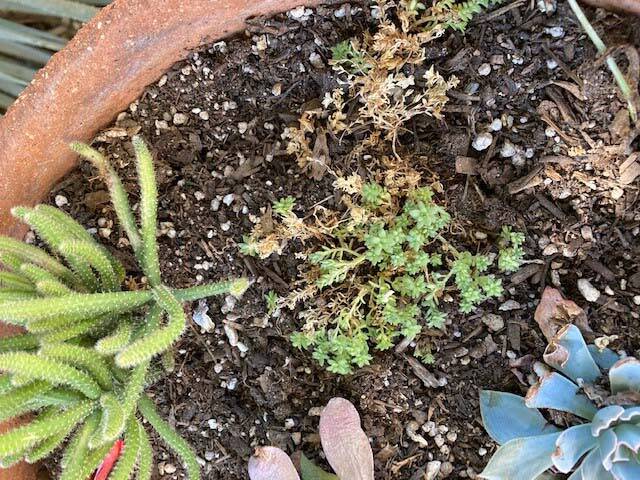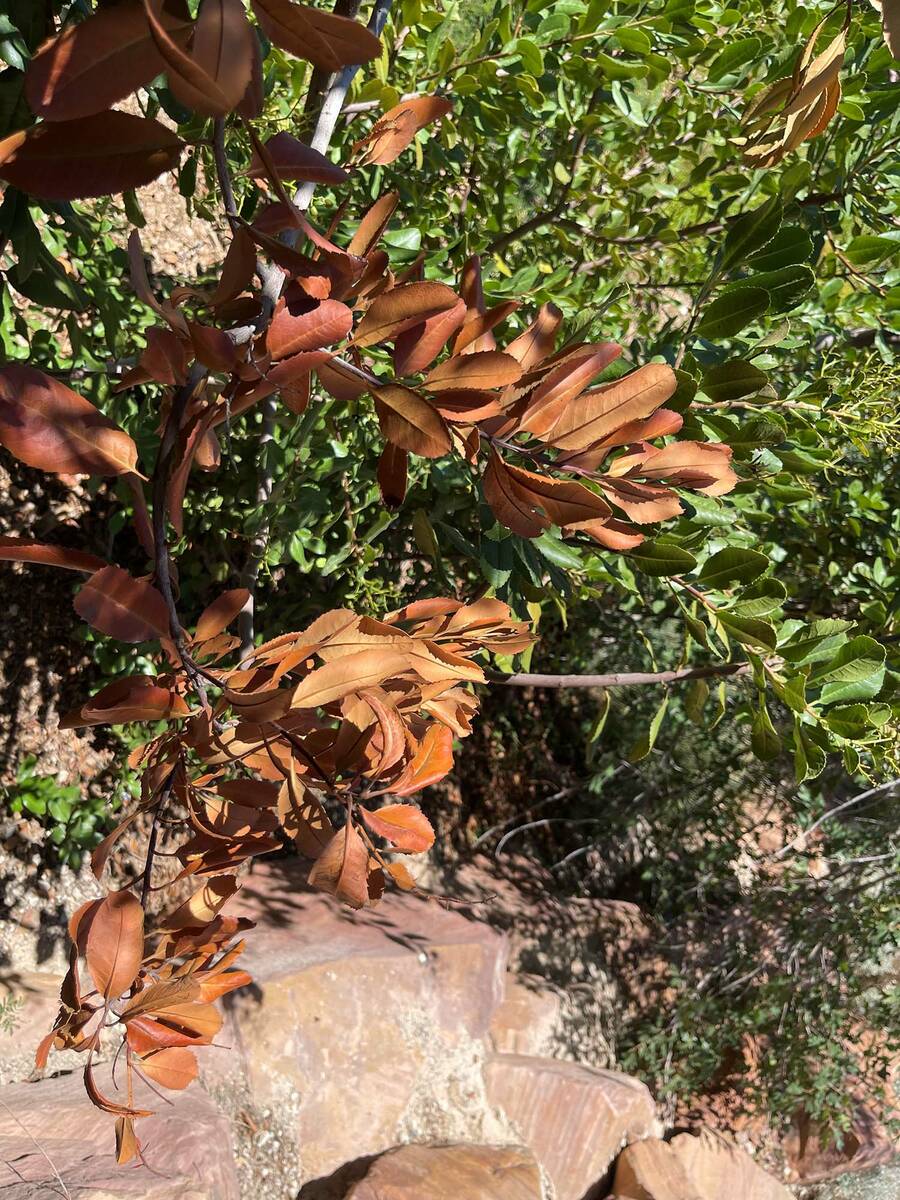Citrus needs extra care in desert
I was accused of not wanting citrus in our area. That isn’t true. Nothing wrong with growing citrus here. But I want you to be aware of its problems when citrus is grown here and adjust your expectations accordingly. This is the Mojave Desert. Las Vegas and the high or middle deserts can have cold winters, unexpected early spring frosts and winds. It can survive cold temperatures ranging from the mid-to-low 20s all the way to no freeze at all depending on the type of citrus.
Early spring light frosts can be a problem for all fruit trees including citrus. All it takes is a few minutes of freezing temperatures just before sunrise. If flowers are open or close to opening, part or all your fruit is dead. The fruit or flowers drop from the trees a week or two later even though bees were plentiful.
All citrus are subtropical. Citrus originates from different parts of Asia. This means they prefer growing in soils that have some organics in them. Desert soils don’t have any or very little. When soils are covered in rock, the soil organics are fine right after planting and last several years. After several years, the soil “organics” used at planting time are depleted and must be replenished. This can be done by raking the rocks back, applying fine wood chips to the soil, and raking the rock back or applying these same amendments over large rock and watering it in.
When purchasing citrus be aware that these are fruit trees that are “iffy” when grown here. Sometimes they work and sometimes they don’t. Adjust your expectations accordingly.
Q. Does this look like fireblight disease to you on established toyon? Toyon is in the rose family of plants.
A. Toyon is a California native plant in the rose family and related to photinia. Both plants are susceptible to fireblight. When the plant is dead it can be hard to say. Sometimes susceptible plants only lose their flowers and sometimes the entire plant dies. With prolonged wet weather this disease can be vicious. Sometimes plants “linger” with this disease, and it can lie dormant until cooler and particularly wet weather.
Look for bacterial “ooze” coming from wounds. This ooze appears as wet spots on tree limbs or the trunk. During wet weather this ooze may attract insects. Observing this plant can be a good way to know; otherwise you have to send it to a plant pathologist to know for sure. When in doubt, assume it’s fireblight and remove it and get the dead plant off the property before it has a chance to spread. Be sure to sterilize any pruning equipment when you are finished.
Q. We have had nutgrass in our lawn (tiff Bermuda) for many years. There used to be a solution that would kill it or keep it at bay. I haven’t seen it for the last three-plus years. It seems unless we can pull out the root and little “nut” at the end, it just keeps spreading. Any suggestions?
A. It used to be that nutgrass (also called nutsedge), both the purple and yellow types, were common problems in nursery soils. Once established in landscapes they were tough to get under control because of the “nut” you mentioned. If the top was killed, the nut would regrow new “blades of grass.” The top, which looked like a lawn grass at first glance, would grow faster than the surrounding grass, or a light green color, and became a problem in well-manicured lawns or other stands of grass.
The best chemical control is with a product containing halosulfuron-methyl. It may be called a trade name like Sledgehammer. That’s why its important to read the ingredients of a chemical and not just the trade or product name. This product may be hard to find so it may require buying it online from DoMyOwn.com pest control.
It will require more than one application to kill the nut. The top will die, and you think it is dead, but the nut may regrow new blades of grass in a few weeks, so watch for it. It is important to follow the label directions for these products exactly. In the past, the problem has been the resprouting of the nut after the top died. It is very important to reapply this chemical as soon as regrowth is seen, or the spreading of the nuts will make the problem worse.
The hybrid bermudagrasses are a good choice for lawns in our area. They can use about 25 percent less water than tall fescues lawns and typically have few weed or disease problems. Just for your information, the “Tiff-type” hybrid bermudagrasses come in different varieties such as Tifdwarf, Tifgreen and Tifway. Tiff-type bermudagrasses are used on golf courses and isn’t the same grass as our weed, Common bermudagrass.
Q. I have received two Meyer lemon trees. I want to know the best place to plant them. My house faces southeast, the sides are northeast and southwest, and backyard faces northwest. Due to very hot summer days is it best to plant on northeast side if the house gets morning sun and shade in afternoon or in the backyard that gets more sun during mid-day to evening? Does direct hot sun harm trees during summer?
A. All these places have their limitations. Probably the most damaging is direct late afternoon sunlight. Plant it where it will get some relief from the late afternoon sun. Plants in orchards are protected by other plants. In our hot desert the intense sunlight is very damaging. It can damage an open area (unshaded) of a fruit tree in less than 20 minutes. Then there are wind problems, particularly in side yards where wind can channel.
Meyer lemon (not a true lemon) is hardy to about 25 F. Select a plant that is bushy with lower limbs as low as possible to shade the trunk. It needs at least six to eight hours of sunlight each day.
Citrus will not like to be surrounded by rock unless the soil is amended. At planting time dig a hole deep enough for the container and three times wider. Make sure at planting time the soil is amended with compost or at least small pieces of wood that will rot with water and fertilizer.
It is OK to surround it with rock but make sure the soil gets a surface application of compost or wood chips once a year. This may mean raking the rock back, applying it, watering it in and then raking the rock back. Or applying the compost/wood chips over the rock and watering it in if the rock is big enough so it does not become an eyesore.
Be careful when pruning. I would let it get established first as a bush and then remove lower limbs only as needed. Shade the trunk as long as possible. Sun, wind and cold are the three things to worry about.
Q. I have a succulent garden which is under our patio cover. Periodically, a plant that seems to being doing well suddenly goes sour. I use a moisture meter and try not to overwater.
A. Sanitation. I am a firm believer in keeping everything as clean as possible. First is the potting soil. When potting soil is reused, sanitize it or get new potting soil.
Do this easily by putting the moist soil, or the entire container a few days after an irrigation, in a clear plastic bag in full sun during the summer. Make sure there are no air leaks. Let it sit like this for about three days. Heating up everything to about 160 F for at least 30 minutes sanitizes it. This method is called solarization.
Sanitize or sterilize all of the equipment with 70 percent ethyl alcohol, particularly anything with a blade.
Use dips. This is dipping new plant and seed, (roots and all except bromeliads and ivy) into a copper fungicide. The most common copper fungicide is called a Bordeaux mix. The copper fungicides protect the plant, cuttings and seed from infection.
Bob Morris is a horticulture expert and professor emeritus of the University of Nevada, Las Vegas. Visit his blog at xtremehorticulture.blogspot.com. Send questions to Extremehort@aol.com.











